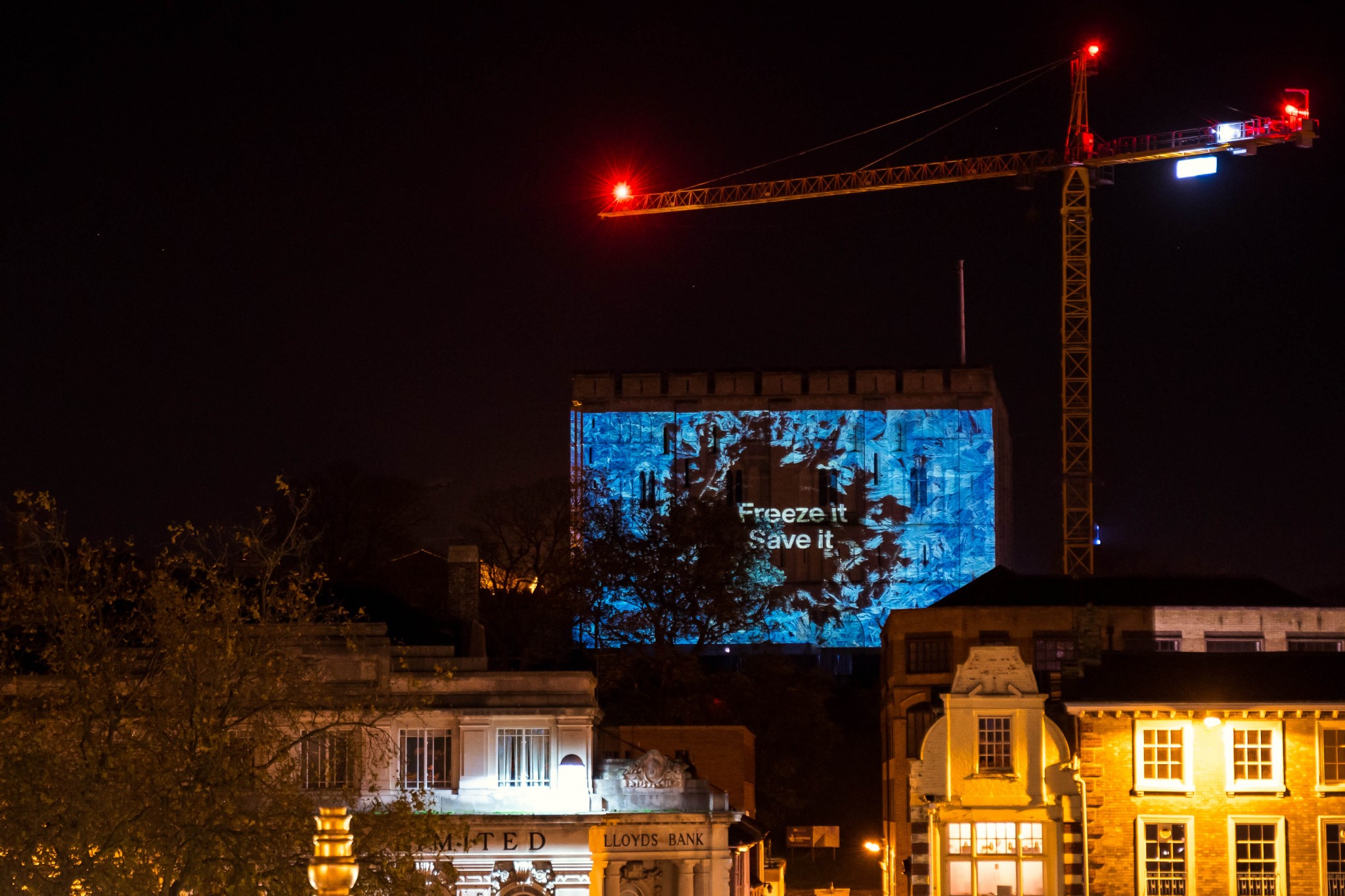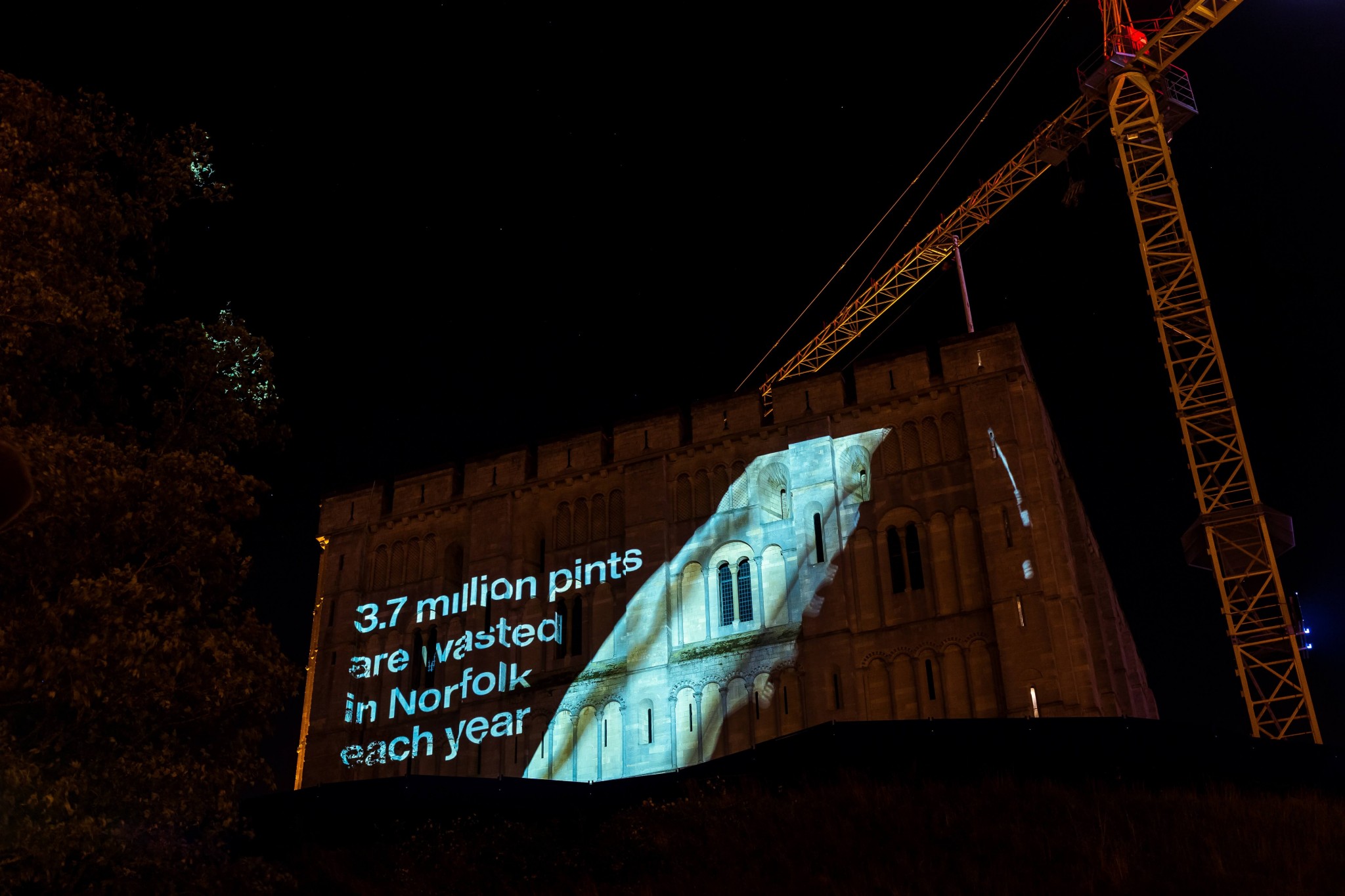A huge light installation came to Norwich today to draw attention to the environmental impact of milk and other foods that are regularly wasted in our homes.
It comes as new research amongst 2,004 Norfolk and Suffolk residents reveals only 1 in 6 people are aware that food waste has more of an impact on climate change than single-use plastic.
The installation arrived as environmental charity Hubbub, Norfolk County Council and the Suffolk Waste Partnership mark two years of their #FoodSavvy campaign to tackle food waste across the counties, and it will be lighting up Norwich Castle for two days (3rd and 4th November).
Along with bread, potatoes and bananas, milk is one of the most frequently wasted foods in households. Whether it’s cow’s, soya, oat or nut milk, a total of 6.7 million pints of milk are thrown away across Norfolk and Suffolk each year – that’s the equivalent of more than 51,000 bathtubs!
The research suggests that over a quarter of people have never frozen milk – an easy way to deal with surplus and one of many tips the campaign is keen to promote.

Whilst the issue of single-use plastic continues to gain momentum amongst consumers and businesses, awareness of the environmental impact of food waste (which has a far greater impact on climate change) is still fairly low in comparison. Fewer than 2 in 5 realise that food waste is a major cause of climate change.
Encouragingly the research also suggests a recent shift in behaviour as 2 in 5 people (41%) say they are throwing away less food since COVID restrictions were introduced.
The top three reasons for this are planning meals more carefully (58%), using the freezer more (51%) and getting better at using leftovers (45%).
Tessa Tricks, Creative Partner at Hubbub said:
“We want to make a splash with this installation and raise awareness of the environmental impact of wasting food and drink.
“We hope that by highlighting the issue of milk waste, people will start to think beyond the plastic bottle it’s often poured from and consider the huge amount of resource and energy that has gone into producing its contents.
“Saving food from going to waste isn’t just a great way to do our bit for the environment – it can also help households save around £700 per year. #FoodSavvy is packed with tips and challenges to help people slash their waste at home.
“We’re calling on families across Norfolk and Suffolk to get on board over the coming months and see what they can save.”
Cllr Andy Grant, Norfolk County Council cabinet member for Environment and Waste, said:
“Lighting up Norwich Castle in this way perfectly represents the amount of milk wasted in both Norfolk and Suffolk every year.
“Our wonderful museum team have calculated that 6.7 million pints of milk would fill the huge space inside the castle keep from the main floor to halfway up to the roof! This is clearly a shocking waste of milk and really hits home how much is just thrown away every year.
“Knowing that on average one-third of our bins at home are food waste shows that if we all do a little bit, together we can make a big difference.”
Cllr James Mallinder, Chairman of the Suffolk Waste Partnership said:
“The milk installation is designed to highlight the amount of food and drink that gets wasted in Suffolk and Norfolk every year – which represents a third of the waste that ends up in Suffolk’s general rubbish bins.
“Not only is this a terrible waste of food but its contribution to climate change is a major concern for us all. Most foods can be frozen, including milk and we hope that this call to action will help remind people to store their food correctly and stop it from going to waste. Small changes in our behaviour can have a big impact over time.”
Launched in 2018, Food Savvy puts East Anglia at the forefront of the UK’s efforts to combat food waste.
The vision of the campaign is to reduce food waste by 20% by 2025 in line with national framework, the Courtauld Commitment and the global Sustainable Development Goals.
Over the past two years, Food Savvy has secured over 100 new partnerships, launched 15 campaigns, and was involved in 70 events across the two counties to raise awareness of the impact of food waste and give people the tools they need to make a difference. 30,000 local people have been involved to date.
The Food Savvy partnership has resources available for local households and organisations. Residents and organisations interested in getting involved in the campaign should visit www.foodsavvy.org.uk.
To help households reduce their food waste here is a list of #FoodSavvy top tips:
- Plan ahead – Take a moment to think about the week ahead. Plan a couple of meals in advance, make a shopping list and buy only what you need.
- Check your fridge – Give your fridge the once over before you buy groceries to ensure you don’t double up.
- Store food carefully – Storing food incorrectly can mean it goes off quicker. Head to www.foodsavvy.org.uk to find out where to store items to keep them at their best. Make sure your fridge is set below 5C, and higher than 1C.
- Make the most of your leftovers – If you cook too much or can’t finish a meal, pack it for lunch or freeze it.
- Love your freezer – If you cook too much or forget to eat something near its use-by date, chances are you can freeze it and eat it later. Most foods can be frozen, including cheese, bread and milk.
